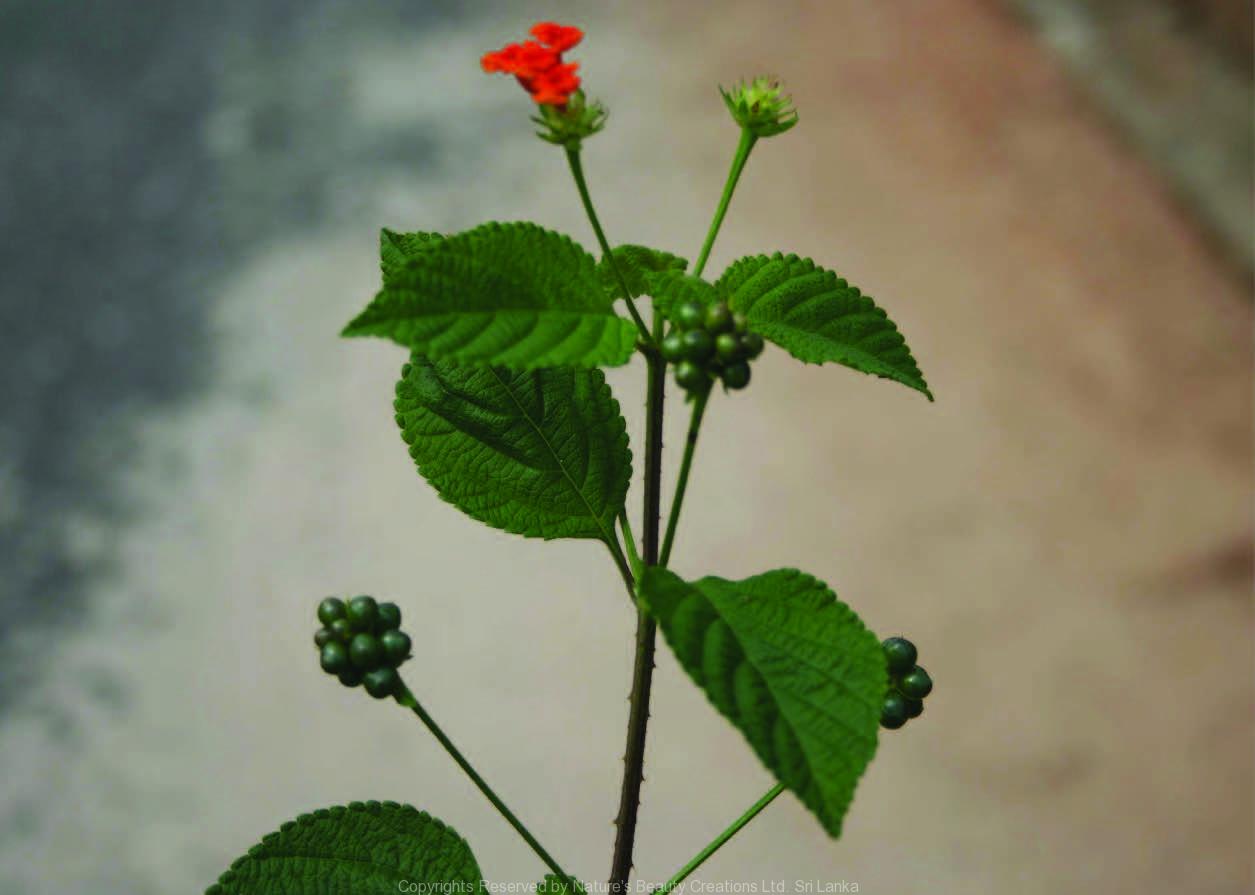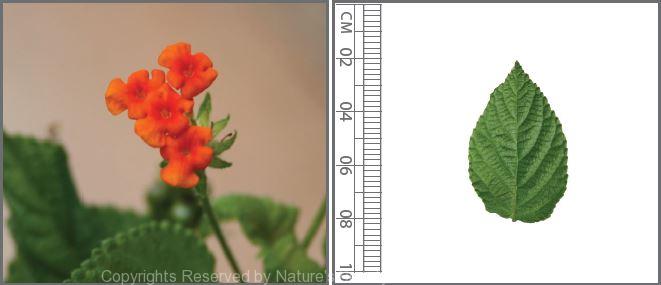

Traditional Knowledge
Useful plant parts :
Leaf and root
Uses in traditional medicine :
- Leaves are used on cuts, ulcers, swellings, rheumatism, constipation, catarrh and bronchitis
- Roots are used in the treatment of toothache, headache, inflammation, gonorrhoea, leucorrhoea and asthma
- Used as a febrifuge, diaphoretic and stimulant
Scientific Research
Chemical constituents:
Stearoyl glucoside of ursolic acid, terpenes: 22-β-acetoxylantic acid, lantadene A and B, lantanoic and camaranoic acids and their derivatives, flavonoids: linaroside, lantanoside from plant; terpenes: germacrene, caryophyllene, phellandrene, limonene and cineole from plant essential oil
Bioactivity :
22-β-acetoxylantic acid: antimicrobial; lantanolic acid derivative: antimutagenic; aqueous alcohol leaf extract: induce embryotoxicity/postimplantation loss; stearoyl glucoside of ursolic acid: hypoglycaemic; lantadene A: antioxidative; essential oil: antimicrobial; methanol extract of leaves: antiulcer; flavonoids: antimycobacterial
Clinical:
Note :
Listed as an alien invasive plant in Sri Lanka
References : Barre, J. T. et al., (1997), A Bioactive triterpene from Lantana camara, Phytochemistry, 45(2), 321-324. Begum, S. et al., (2008), Antimycobacterial activity of flavonoids from Lantana camara Linn, Nat Prod Res, 22(6), 467-70. Begum, S. et al., (2008), Two new pentacyclic triterpenoids from Lantana camara Linn., Chem Pharm Bull, 56(9), 1317-20. Garcia, A. F. et al., (2010), Comparative effects of lantadene A and its reduced metabolite on mitochondrial bioenergetics, Toxicon, 55, 1331-1337. Ghisalberti, U. E. L., (2000), Lantana camara L. (Verbenaceae), Fitotera- pia, 71, 467-486. Grace-Lynn, C. et al., (2012), In vitro antioxidant activity potential of lantadene A, a pentacyclic triterpenoid of Lantana plants, Molecules, 17(9), 11185-98. Kazmi, I. et al., (2012), Anti-diabetic potential of ursolic acid stearoyl glucoside: A new triterpenicgycosidic ester from Lantana camara, Fitoterapia, 83, 142-146. Mello, F. B. et al., (2005), Effects of Lantana camara (Verbenaceae) on general reproductive performance and teratology in rats, Toxicon, 45, 459-466. Misra, L. and Laatsch, H., (2000), Triterpenoids, essential oil and photo-oxidative 28–13-lactonization of oleanolic acid from Lantana camara, Phytochemistry, 54, 969-974. Mukherjee, P. K. et al., (2006), Leads from Indian medicinal plants with hypoglycemic potentials, Journal of Ethnopharmacology, 106, 1-28. Sathish, R. et al., (2011), Antiulcerogenic activity of Lantana camara leaves on gastric and duodenal ulcers in experimental rats, J Ethnophar- macol, 134(1), 195-7. Sharma, U. O. P. et al., (2000), Levels of lantadenes, bioactive pentacy- clic triterpenoids, in young and mature leaves of Lantana camara var. aculeate, Fitoterapia, 71, 487-491. Siddiqui, B. S. et al., (1995), Pentacyclic Triterpinoids from Lantana camara, Phytochemistry, 38(3), 681-685. Tesch, N. R. et al., (2011), Chemical composition and antibacterial activity of the essential oil of Lantana camara var. moritziana, Nat Prod Commun, 6(7), 1031-4. Verdeguer, M. et al., (2009), Phytotoxic effects of Lantana camara, Eucalyptus camaldulensis and Eriocephalus africanus essential oils in weeds of Mediterranean summer crops, Biochemical Systematics and Ecology, 37, 362-369.
Copyrights Reserved By
Natures Beauty Creations




